MIM-23 Hawk
The Raytheon MIM-23 Hawk is an American medium-range surface-to-air missile. It was designed to be a much more mobile counterpart to the MIM-14 Nike Hercules, trading off range and altitude capability for a much smaller size and weight. Its low-level performance was greatly improved over Nike through the adoption of new radars and a continuous wave semi-active radar homing guidance system.
| MIM-23 Hawk | |
|---|---|
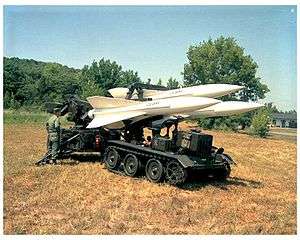 MIM-23 Hawk | |
| Type | Surface-to-air missile |
| Place of origin | United States |
| Service history | |
| In service | August 1960[1]–present |
| Production history | |
| Manufacturer | Raytheon Company |
| Unit cost | $250,000 per missile $15 million per fire unit $30 million per battery |
| Specifications | |
| Mass | 1,290 pounds (590 kg) |
| Length | 16 feet 8 inches (5.08 m) |
| Diameter | 14.5 inches (370 mm) |
| Warhead | 119 pounds (54 kg) blast fragmentation warhead |
| Engine | solid-fuel rocket engine |
| Wingspan | 3 feet 11 inches (1.19 m) |
Operational range | 45–50km |
| Flight ceiling | 65,000 feet (20,000 m) |
| Maximum speed | Mach 2.4 |
Guidance system | Semi-active radar homing |

Hawk was originally intended to attack aircraft, especially those flying at medium and low altitudes. It entered service with the Army in this role in 1959. In 1971 it underwent a major improvement program as the Improved Hawk, or I-Hawk, which made several improvements to the missile and replaced all of the radar systems with new models. Improvements continued throughout the next twenty years, adding improved ECCM, a potential home-on-jam feature, and in 1995, a new warhead that made it capable against short-range tactical missiles. Jane's reported that the original system's single shot kill probability was 0.56; I-Hawk improved this to 0.85.[2]
Hawk was superseded by the MIM-104 Patriot in US Army service by 1994. The last US user was the US Marine Corps, who used theirs until 2002 when they were replaced with the man-portable short-range FIM-92 Stinger. The missile was also produced outside the US in Western Europe, Japan and Iran.[3] The US never used the Hawk in combat, but it has been employed numerous times by other nations. Approximately 40,000 of the missiles were produced.
Development
Development of the Hawk missile system began in 1952, when the United States Army began studies into a medium-range semi-active radar homing surface-to-air missile. In July 1954 development contracts where awarded to Northrop for the launcher, radars and fire control systems, while Raytheon was awarded the contract for the missile. The first test launch of the missile then designated the XSAM-A-18 happened in June 1956. By July 1957 development was completed, by which time the designation had changed to XM3 and XM3E1. Very early missiles used the Aerojet M22E7 which was not reliable; the problems were resolved with the adoption of the M22E8 engine.
The missile was initially deployed by the US Army in 1959, and by the US Marine Corps in 1960.
The high complexity of the system, and the quality of tube-based electronics, gave the radars in the early Hawk systems a mean time between failures (MTBF) of only 43 hours. The improved Hawk system increased this to between 130 and 170 hours. Later Hawk versions improved this further to between 300 and 400 hours.
Improved Hawk or I-Hawk The original Hawk system had problems engaging targets at low altitude—the missile would have problems picking the target out against ground clutter. The US Army began a program to address these issues in 1964 via the Hawk Improvement Program (Hawk/HIP). This involved numerous upgrades to the Hawk system:
- A digital data processing central information coordinator for target processing, threat ordering, and intercept evaluation.
- An improved missile (MIM-23B) with a larger warhead, smaller and more powerful M112 motor, and improved guidance section.
- The PAR, CWAR, HPIR, and ROR were replaced by upgraded variants (see #Radars).
The system entered service during 1972, the first unit reaching operational status by October. All US units were upgraded to I-Hawk standard by 1978.
Product Improvement Plan In 1973 the US Army started an extensive multi-phase Hawk PIP (Product Improvement Plan), mainly intended to improve and upgrade the numerous items of ground equipment.
- Phase I
- Phase I involved replacement of the CWAR with the AN/MPQ-55 Improved CWAR (ICWAR), and the upgrade of the AN/MPQ-50 PAR to Improved PAR (IPAR) configuration by the addition of a digital MTI (Moving Target Indicator). The first PIP Phase I systems were fielded between 1979 and 1981.
- Phase II
- Developed from 1978 and fielded between 1983 and 1986. upgraded the AN/MPQ-46 HPI to AN/MPQ-57 standard by replacing some of the vacuum tube based electronics with modern solid-state circuits, and added an optical TAS (Tracking Adjunct System). The TAS, designated OD-179/TVY, is an electro-optical (TV) tracking system that increases Hawk operability and survivability in a high-ECM environment.
- Phase III
- The PIP Phase III development was started in 1983, and was first fielded by U. S. forces in 1989. Phase III was a major upgrade which significantly enhanced the computer hardware and software for most components of the system, a new CWAR the AN/MPQ-62, added single-scan target detection capability, and upgraded the HPI to AN/MPQ-61 standard by addition of a Low-Altitude Simultaneous Hawk Engagement (LASHE) system. LASHE allows the Hawk system to counter saturation attacks by simultaneously intercepting multiple low-level targets. The ROR was phased out in Phase III Hawk units.
Hawk Missile Restore Reliability (MRR)
- This was a program that ran between 1982 and 1984 intended to improve missile reliability.
Hawk ECCM
- Running alongside the MMR program, this produced ECCM to specific threats, probably contemporary Soviet ECM pods such as the SPS-141 fitted to the Su-22, which proved moderately effective during the Iran–Iraq War. The MIM-23C and E missiles contain these fixes.
Low clutter enhancements
- Upgrades to the missile that takes it up to MIM-23G that enable the missile to deal with low flying targets in a high clutter environment. These were first deployed in 1990.
Hawk missile ILM (Improved lethality modification)
- To improve the lethality of the warhead of the missile against ballistic missiles, the warhead was redesigned to produce fewer larger fragments, typically 35 grams each comparable to a 12.7 mm projectile in mass.
Hawk mobility and TMD upgrades
- A Hawk mobility survivability enhancement programme has been developed following experience in the 1990 Gulf War. The aim of this programme was to reduce the number of support vehicles per battery and to increase survivability. Upgrades to the launcher allow missiles to be transported on the launcher itself, as well as replacing vacuum tubes with a single laptop computer. A north finding system speeds orientation and launcher alignment. A field wire replaces heavy cables and allows for greater dispersion amongst battery vehicles from 110 m to 2 km. The upgrades were deployed by the US Marine Corps between early 1995 and September 1996.
Phase IV
- With both the Army and Marines abandoning the Hawk, phase IV was never completed. It was planned to include:
- High mobility continuous wave acquisition radar to improve detection of small UAVs.
- A new CW engagement radar.
- Anti-radiation missile decoys.
- An improved missile motor.
- An upgraded electro-optical tracker.
- Improved command and control.
- ATBM upgrades.
Hawk XXI (Hawk 21)
- The Hawk XXI or Hawk-21 is a more advanced, and more compact version of Hawk PIP-3 upgrade. Hawk-XXI basically eliminates the PAR and CWAR radars with the introduction of 3D MPQ-64 Sentinel radars. Norway's Kongsberg Company provides an FDC (Fire Distribution Center) as it is used in NASAMS system in Norway. The missiles are upgraded MIM-23K standard with an improved blast-fragmentation warhead that creates a larger lethal zone. The system is also effective against short-range tactical ballistic missiles.
- A MPQ-61 HIPIR radar provides low altitude and local area radar coverage as well as continuous wave radar illumination for the MIM-23K Hawk missiles.
Description

The Hawk system consists of a large number of component elements. These elements were typically fitted on wheeled trailers making the system semi-mobile. During the system's 40-year life span, these components were continually upgraded.
The Hawk missile is transported and launched from the M192 towed triple-missile launcher. A self-propelled Hawk launcher, the SP-Hawk, was fielded in 1969, which simply mounted the launcher on a tracked M727 (modified M548), however the project was dropped and all activity terminated in August 1971.
The missile is propelled by a dual thrust motor, with a boost phase and a sustain phase. The MIM-23A missiles were fitted with an M22E8 motor which burns for 25 to 32 seconds. The MIM-23B and later missiles are fitted with an M112 motor with a 5-second boost phase and a sustain phase of around 21 seconds. The M112 motor has greater thrust, thus increasing the engagement envelope.
The original MIM-23A missiles used a parabolic reflector, but the antenna directional focus was insufficient, when engaging low flying targets the missile would dive on them, only to lose them in the ground clutter. The MIM-23B I-Hawk missiles and later uses a low side lobe, high-gain plane antenna to reduce sensitivity to ground clutter in addition to an inverted receiver developed in the late 1960s to give the missile enhanced ECCM ability and to increase the Doppler frequency resolution.
A typical Basic Hawk battery consists of:
- 1 × PAR: Pulse Acquisition Radar—a search radar with a 20 rpm rotation, for high/medium altitude target detection.
- 1 × CWAR: Continuous Wave Acquisition Radar—a search doppler radar with a 20 rpm rotation, for low altitude target detection.
- 2 × HPIR: High Power Illuminator doppler Radar—target tracking, illumination and missile guidance.
- 1 × ROR: Range Only Radar—K-band pulse radar which provides range information when the other systems are jammed or unavailable.
- 1 × ICC: Information Coordination Central
- 1 × BCC: Battery Control Central
- 1 × AFCC: Assault Fire Command Console—miniature battery control central for remote control of one firing section of the battery. The AFCC controls one CWAR, one HPI, and three launchers with a total of nine missiles.
- 1 × PCP: Platoon Command Post
- 2 × LCS: Launcher Section Controls
- 6 × M-192: Launchers with 18 missiles.
- 6 × SEA: Generators 56 kVA (400 Hz) each.
- 12 × M-390: Missile transport pallets with 36 missiles
- 3 × M-501: Missile loading tractors.
- 1 × [bucket loader]
- 1 × Missile test shop AN/MSM-43.
A typical Phase-III Hawk battery consists of:
- 1 × PAR: Pulse Acquisition Radar—a search radar with a 20 (+/−2) rpm rotation, for high/medium altitude target detection.
- 1 × CWAR: Continuous Wave Acquisition Radar—a search doppler radar with a 20 (+/−2) rpm rotation, for low altitude target detection.
- 2 × HIPIR: HIgh Power Illuminator doppler Radar—target tracking, illumination and missile guidance.
- 1 × FDC: Fire Direction Center
- 1 × IFF: Identification Friend or Foe Transceiver
- 6 × DLN: Digital Launchers with 18 missiles.
- 6 × MEP-816: Generators 60KW (400 Hz) each.
- 12 × M-390: Missile transport pallets with 36 missiles
- 3 × M-501: Missile loading tractors.
- 1 × [bucket loader]
Missiles
| Type of Missile | Entered service | Tactical model | Training and Evaluation model |
|---|---|---|---|
| Prototype | 1957 | XM3 (XMIM-23A) | n/a |
| Basic Hawk | 1959 | (M3) MIM-23A | XM16/18 (XMTM-23B/C) |
| Basic I-Hawk | 1971 to 1978 | MIM-23B | XMEM-23B |
| Improved ECCM | 1982 | MIM-23C/D | MEM-23C |
| Low-level/ multi-jamming | 1990 | MIM-23E/F | MEM-23D |
| New body section | early 1990s | MIM-23G/H | MEM-23E |
| New warhead and fuzing (anti-TBM) | 1995 | MIM-23K/J | MEM-23F |
| New fuzing only, old warhead | 1995 | MIM-23L/M |
The Hawk missile has a slender cylindrical body and four long chord clipped delta-wings, extending from mid-body to the slightly tapered boat-tail. Each wing has a trailing-edge control surface.
- The MIM-23A is 5.08 metres (16.7 ft) long, has a body diameter of 0.37 metres (1 ft 3 in), a wing span of 1.21 metres (4 ft 0 in) and weighs 584 kilograms (1,287 lb) at launch with a 54 kilograms (119 lb) HE blast/fragmentation warhead. It has a minimum engagement range of 2 kilometres (1.2 mi), a maximum range of 25 kilometres (16 mi), a minimum engagement altitude of 60 metres (200 ft) and a maximum engagement altitude of 11,000 metres (36,000 ft).
- The MIM-23B to M versions are 5.03 m (16.5 ft) long, have a body diameter of 0.37 m (1 ft 3 in) and, with a larger warhead of 75 kg (165 lb), weighing 638 kg (1,407 lb) at launch. An improved motor, with a total weight of 395 kg (871 lb) including 295 kg (650 lb) of propellant, increases the maximum range of the MIM-23B to M versions to 35 km (22 mi) and maximum engagement altitude to 18,000 m (59,000 ft). The minimum range is reduced to 1.5 km (0.93 mi). The MIM-23B has a peak velocity of around 500 m/s (1,600 ft/s). The missile is fitted with both radio frequency proximity and impact fuses. The guidance system uses an X-band CW monopulse semi-active radar seeker. The missile can maneuver at 15 g.
In the 1970s, NASA used surplus Hawk missiles to create the Nike Hawk sounding rocket.[4]
Basic Hawk: MIM-23A
The original missile used with the system. The 54-kilogram (119 lb) warhead produces approximately 4,000 8-gram (0.28 oz) fragments that move at approximately 2,000 meters per second (6,600 ft/s) in an 18 degree arc.
I-Hawk: MIM-23B
The MIM-23B has a larger 74 kg (163 lb) blast-fragmentation warhead, a smaller and improved guidance package, and a new M112 rocket motor. The new warhead produces approximately 14,000 2-gram (0.071 oz) fragments that cover a much larger 70 degree arc. The missiles M112 rocket motor has a boost phase of 5 seconds and a sustain phase of 21 seconds. The motors total weight is 395 kg (871 lb) including 295 kg (650 lb) of propellant. This new motor improves the engagement envelope to 1.5 to 40 km (0.93 to 24.85 mi) in range at high altitude, and 2.5 to 20 km (1.6 to 12.4 mi) at low altitude, the minimum engagement altitude is 60 meters (200 ft). The missile was operational in 1971. All US units had converted to this standard by 1978.
- MTM-23B training missile.
- XMEM-23B Full telemetry version for testing and evaluation purposes.
System components
The Hawk and Improved Hawk structure was integrated into one system—AN/TSQ-73 air defense missile control and coordination system, called Missile Minder or Hawk-MM. It consists of the following components: MPQ-50 Pulse Acquisition Radar, MPQ-48 Improved Continuous Wave Acquisition Radar, TSW-8 Battery Control Central, ICC Information Coordination Central, MSW-11 Platoon Command Post, MPQ-46 High Power Illuminator, MPQ-51 Range Only Radar and the M192 Launcher.[5]
Improved ECCM
| 1959 Basic HAWK | MIM-23A | ||||||||||||||||||||||||||||||||||||||
| 1971 I Hawk | MIM-23B | ||||||||||||||||||||||||||||||||||||||
| 1982 Improved ECCM | MIM-23C | ||||||||||||||||||||||||||||||||||||||
| MIM-23D | |||||||||||||||||||||||||||||||||||||||
| 1990 Improved guidance section and ECCM | MIM-23E | MIM-23F | |||||||||||||||||||||||||||||||||||||
| Improved body section | MIM-23G | MIM-23H | |||||||||||||||||||||||||||||||||||||
| Anti-TBM configuration | MIM-23K | MIM-23J | |||||||||||||||||||||||||||||||||||||
| Enhanced fuse | MIM-23L | MIM-23M | |||||||||||||||||||||||||||||||||||||
- MIM-23C
Introduced around 1982 with improved ECCM capabilities.
- MIM-23D
Unknown upgrade to the MIM-23C. The C and D missile families remained separate until the missiles' exit from service. It is not clear exactly what the difference between the two missiles - however it seems likely that the D family missiles represent an alternative guidance system, possibly home on jam developed in response to Soviet ECM techniques that were used by Iraq during the Iran-Iraq War.
Low level/multi jamming
- MIM-23E/F
An upgraded to the MIM-23C/D missiles improved guidance for low level engagements in a high clutter/multi-jamming environment. Introduced in 1990.
New body section
- MIM-23G/H
A 1995 upgrade consisting of a new body section assembly for the MIM-23E/F missiles.
New warhead + fuzing (anti-TBM)
- MIM-23K/J
Introduced around 1994. Enhanced lethality configuration warhead with 35 gram (540 grain) fragments instead of the I-Hawks 2 gram (30 grain) fragments. MIM-23K Hawk missiles are effective up to 20,000 m altitude and up to 45 km in range. The missile also includes a new fuse to make it effective against ballistic missiles.
New fuzing + old warhead
- MIM-23L/M
Retains the I-Hawks 30 grain warhead, but with the new fuse.
Radars
The original Hawk system used 4 or in some models 6 radars: to detect (PAR and CWAR), to track (CWAR and HPIR) and to engage (HPIR and ROR) targets. As the system was upgraded the functionality of some of the radars was merged. The final iteration of the system consists of only 2 radars, an enhanced phased array search radar and an engagement radar (HPIR).
| System | Basic Hawk 1959 | Improved Hawk 1971 | PIP Phase I 1979 | PIP Phase II 1983 to 1986 | PIP Phase III 1989 | Hawk XXI |
|---|---|---|---|---|---|---|
| PAR | AN/MPQ-35 | AN/MPQ-50 | AN/MPQ-64 | |||
| CWAR | AN/MPQ-34 | AN/MPQ-48 | AN/MPQ-55 | AN/MPQ-62 | ||
| HPIR | AN/MPQ-33/39 | AN/MPQ-46 | AN/MPQ-57 | AN/MPQ-61 | ||
| ROR | AN/MPQ-37 | AN/MPQ-51 | ||||
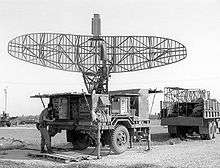
- PAR Pulse Acquisition Radar
The pulse acquisition radar is a long-range, high-altitude search radar.
- AN/MPQ-35 (Basic Hawk)
The search radar used with the basic Hawk system, with a radar pulse power of 450 kW and a pulse length of 3 µs, a Pulse Repetition Frequency of 800 and 667 Hz alternately. The radar operates in the 1.25 to 1.35 GHz range. The antenna is a 6.7 m × 1.4 m (22.0 ft × 4.6 ft) elliptical reflector of open lattice construction, mounted on a small two-wheeled trailer. Rotation rate is 20 rpm, the BCC – Battery Control Central and the CWAR are synchronized by the PAR revolutions and the PAR system trigger.
- AN/MPQ-50 (Improved Hawk to Phase III)
Introduced with the I-Hawk system, the improved-PAR. The system introduces a digital MTI (Moving Target Indicator) that helps separate targets from ground clutter. It operates in the 500 to 1,000 MHz (C-band) frequency range with a peak operating power of 1,000 watts.
- Range (source Janes):
- 104 km (65 mi) (high PRF) to 96 km (60 mi) (low PRF) versus 3 m2 (32 sq ft) target.
- 98 km (61 mi)(high PRF) to 90 km (56 mi) (low PRF) versus 2.4 m2 (26 sq ft) target.
- 79 km (49 mi) (high PRF) to 72 km (45 mi) (low PRF) versus 1 m2 (11 sq ft) target.

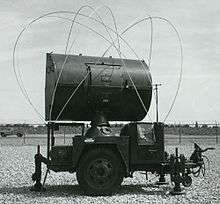
- AN/MPQ-64 Sentinel (Hawk XXI)
A X-Band 3D range-gated doppler radar system used with the Hawk XXI system. It replaces both the CWAR and PAR components of the Hawk system. MPQ-64 Sentinel provides coverage out to a range of 75 km (47 mi), rotating at 30 rpm. The system has a mean time between failure of around 600 hours, and can track at least 60 targets at once. It can elevate up to +55 degrees and depress to −10 degrees.[6]
- CWAR Continuous Wave Acquisition Radar
This X Band Continuous wave system is used to detect targets. The unit comes mounted on its own mobile trailer. The unit acquires targets through 360 degrees of azimuth while providing target radial speed and raw range data.
- AN/MPQ-34 (Basic Hawk)
MPQ-34 Hawk CW Acquisition radar with a power rating of 200 W and a frequency of 10 GHz (X-Band) Built by Raytheon. Replaced by MPQ-48.
- AN/MPQ-48 (Improved Hawk)
The Improved Hawk version of the CW acquisition radar doubled the output power and improved the detection ranges:
- Range (source Janes):
- 69 km (43 mi) (CW) to 63 km (39 mi) (FM) versus 3 m2 (32 sq ft) target.
- 65 km (40 mi) (CW) to 60 km (37 mi) (FM) versus 2.4 m2 (26 sq ft) target.
- 52 km (32 mi) (CW) to 48 km (30 mi) (FM) versus 1 m2 (11 sq ft) target.
- AN/MPQ-55 (Phase I – Phase II)
Hawk Improved Continuous Wave Acquisition Radar or ICWAR. The output power is doubled to 400 W, this increases the detection range to around 70 km (43 mi). The radar operates in the 10–20 GHz (J band). Other features include FM ranging and BITE (Built in test equipment). Frequency modulation is applied to the broadcast on alternate scans of the ICWAR to obtain range information.
- AN/MPQ-62 (Phase III)
Some changes to the signal processing allow the radar to determine the targets' range and speed in a single scan. A digital DSP system is added which allows a lot of the processing work to be done on the radar directly and forwarded directly via a serial digital link to the PCP/BCP.
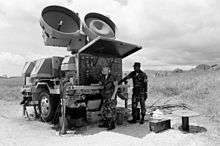
- HPIR High Power Illuminating Radar
The early AN/MPQ-46 High Power Illuminator (HPIR) radars had only the two large dish-type antennas side by side, one to transmit and one to receive. The HPIR automatically acquires and tracks designated targets in azimuth, elevation and range. It also serves as an interface unit supplying azimuth and elevation launch angles computed by the Automatic Data Processor (ADP) in the Information Coordination Centre (ICC) to the IBCC or the Improved Platoon Command Post (IPCP) for up to three launchers. The HPIR J-band energy reflected from the target is also received by the Hawk missile. These returns are compared with the missile reference signal being transmitted directly to the missile by the HPIR. Target tracking is continued throughout the missile's flight. After the missile intercepts the target the HPIR Doppler data is used for kill evaluation. The HPIR receives target designations from one or both surveillance radars via the Battery Control Centre (BCC) and automatically searches a given sector for a rapid target lock on. The HPIR incorporates ECCM and BITE.
- AN/MPQ-33/39 (Basic Hawk)
This X Band CW System is used to illuminate targets in the Hawk Missile Battery. The unit comes mounted on its own mobile trailer. Unit automatically acquires and tracks designated targets in azimuth elevation and range rate. The system has an output power of around 125 W operating in the 10–10.25 GHz band. MPQ-39 was an upgraded version of the MPQ-33.
- AN/MPQ-46 (Improved Hawk – Phase I)
The radar operates in the 10–20 GHz (J band) region. Many of the electron tube components in earlier radars are replaced with solid-state technology.
- Range (source Janes):
- 99 km (62 mi) (high PRF) to 93 km (58 mi) (low PRF) versus 3 m2 (32 sq ft) target.
- 93 km (58 mi) (high PRF) to 89 km (55 mi) (low PRF) versus 2.4 m2 (26 sq ft) target.
- 75 km (47 mi) (high PRF) to 72 km (45 mi) (low PRF) versus 1 m2 (11 sq ft) target.
- AN/MPQ-57 (Phase II)
The majority of the remaining tube electronics are upgraded to solid state. Also, an electro-optical tracking system, the daytime only OD-179/TVY TAS (Tracking Adjunct System) is added for operation in a high ECM environment. The TAS was developed from the US Air Forces TISEO (Target Identification System, Electro-Optical) by Northrop. It consists of a video camera with a ×10 zoom lens. The I-TAS which was field tested in 1992 added an Infra Red capability for night operation as well as automatic target detection and tracking.
- HEOS Germany, Netherlands and Norway modified their Hawk systems with an alternative IR acquisition and tracking system known as the Hawk Electro-Optical Sensor (HEOS) in place of the TAS. HEOS operates in the 8 to 11 µm band and is used to supplement the HPI to acquire and track targets before missile launch.
- AN/MPQ-61 (Phase III)
Upgraded with the addition of the LASHE (Low-Altitude Simultaneous Hawk Engagement) system, which allows the Hawk to engage multiple low level targets by employing a fan beam antenna to provide a wide-angle, low-altitude illumination pattern to allow multiple engagements against saturation raids. This antenna is rectangular. This allows up to 12 targets to be engaged at once. There is also TV/IR optic system for passive missile guidance.
- ROR Range Only Radar
Pulse radar that automatically comes into operation if the HPIR radar cannot determine the range, typically because of jamming. The ROR is difficult to jam because it operates only briefly during the engagement, and only in the presence of jamming.
- AN/MPQ-37 (Basic Hawk)
- AN/MPQ-51 (Improved Hawk – Phase II)
A Ku Band (Freq: 15.5-17.5 GHz) pulse radar, the power output was 120 kW. Pulse length 0.6 µs at a pulse repetition frequency of 1600 Hz. Antenna: 4-foot (1.2 m) dish.
- Range
- 83 km (52 mi) versus 3 m2 (32 sq ft) target.
- 78 km (48 mi) versus 2.4 m2 (26 sq ft) target.
- 63 km (39 mi) versus 1 m2 (11 sq ft) target.
FDC (Hawk Phase III and Hawk XXI) – Fire Distribution Center. C4I unit, enabling modern command, control, communications and Force Operation. Color displays with 3D map overlays enhance the situation awareness. Introduces the real-time exchange of air picture and commands between the Hawk units. Make-ready capability for SL-AMRAAM and SHORAD/vSHORAD systems.
Country-specific modifications
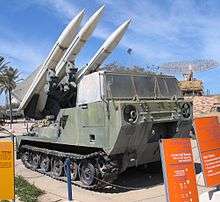
- Israel
The Israelis have upgraded the Phase 2 standard with the addition of a Super Eye electro-optical TV system for detection of aircraft at 30 to 40 km and identification at 17 to 25 km. They have also modified their system for engagements at altitudes up to 24,000 m.
- Sparrow Hawk
A composite system firing AIM-7 Sparrow missiles from a modified 8 round launcher. The system was demonstrated at the China Lake weapons test site in 1985. There are currently no users of the system.
- Hawk AMRAAM
At "Safe Air 95" AMRAAM missiles were demonstrated being fired from a modified M192 missile launcher. The normal battery radar is used for the engagement, with the missile's own radar used for terminal homing. Raytheon and Kongsberg are offering this system as an upgrade to the existing Hawk system. This proposal is aimed particularly at Hawk operating countries that also have AIM-120 AMRAAM in their inventory. Norway is currently operating this type of system as NASAMS.
- Iran
As part of what became known as the Iran–Contra affair, Hawk missiles were some of the weaponry sold to Iran, in violation of an arms embargo, to fund the Contras.
The Islamic Republic of Iran Air Force is reported to have experimented with a number of MIM-23 Hawk missiles for carriage on F-14 Tomcat fighters in the air-to-air role under a program known as Sky Hawk. Iran has also modified its ground-based Hawk systems for carriage on a convoy of 8×8 wheeled vehicles and adapted the launchers to carry Standard RIM-66 or AGM-78 missiles with two Standard missiles per launcher.
The Iranian Air Force has its own version of the MIM-23 Hawk, the Shahin, which it claims to be under production. In 2010 Iran announced that it will mass-produce its next generation of air defense system called Mersad, which would integrate with the Shahin missile.[7]
- Norway
Norway has developed its own Hawk upgrade scheme known as the Norwegian Adapted Hawk (NOAH) which involves the lease of I-Hawk launchers, HPI radars and missile loaders from the United States and their integration with Hughes (now Raytheon) Kongsberg Acquisition Radar and Control Systems. The NOAH system became operational in 1988. It was replaced by NASAMS in the period 1995–98.
- ACWAR
Future developments were expected to include the introduction of an Agile CW Acquisition Radar (ACWAR), an evolution of the Hawk CW radar technology. It would perform full 3-D target acquisition over a 360° azimuth sector and large elevation angles. The ACWAR programme was initiated to meet increasingly severe tactical air defence requirements and the equipment is being designed for operation of Hawk in the late 1990s and beyond. However, the ACWAR programme was terminated in 1993.
Combat history
- August 1962: agreement in principle was reached between the US and Israeli governments for the sale of Hawk missiles to Israel.
- October–November 1962: the Cuban Missile Crisis necessitates a request for a total of 304 missiles to be delivered at an average turnaround of three days per missile.
- February–March 1965: the United States Marine Corps deploys Hawk at Da Nang and Hill 327. This was both the first USMC deployment of the Hawk, and also the first deployment of the Hawk in Vietnam.
- March 1965: the first Hawk battalion was deployed to Israel.
- June 5, 1967: in an unusual incident an Israeli MIM-23A shot down a damaged Israeli Dassault MD.450 Ouragan that was in danger of crashing into the Negev Nuclear Research Center near Dimona, being the first combat firing of the Hawk and the first combat kill attributed to the Hawk system.[8]
- March 21, 1969: a Hawk battery deployed at Baluza, in the Sinai region, detected an Egyptian MiG-21 aircraft which took off from Port Said airport. The aircraft was tracked on the radar and when the MiG-21 broke to a course heading towards the Hawk battery, a missile shot it down.[9]
- War of Attrition: Hawk batteries shot down between 8 and 12 aircraft.[10] Jane's reports 12 kills as one Il-28, four Su-7, four MiG-17 and three MiG-21.
- May 1972: improved Hawk support equipment first deployed to Germany.
- 1977: all US Army units in Europe and Korea completed conversion of Basic to Improved Hawk by the end of the year.
- Iran–Iraq War 1980–1988: at least 40 Iraqi aircraft were destroyed by Iranian Hawk missiles during the Iran–Iraq War. On February 12, 1986, 9 Iraqi aircraft downed by a Hawk site near al-Faw in southern Iraq during Operation Dawn 8. Among the aircraft are Su-22s and MiG-23s.[11] Additionally, Iranian Hawk sites shot down three friendly F-14 Tomcats and 1 F-5 Tiger II.[12][13] Kuwait also shot down an Iranian F-5.
- March 1985: DA and the Office of the Secretary of Defense (OSD) approved the development of an anti-tactical missile (ATM) mission for Hawk.
- September 7, 1987: the French Army's 403nd Air Defense Regiment in Chad shot down a Libyan Tu-22B on a bombing mission with an MIM-23B during the Chadian–Libyan war. The particularity of this event is with its geographical situation, a few miles from a border. The attack began outside the Chadian territory proper and left the French with only a very small window of opportunity to shoot the intruder. The interception took place almost at the vertical of the battery. Debris and unexploded bombs from the Tu-22 rained over the position but injured no one.
- August 2, 1990: Hawk missiles defending Kuwait against the Iraqi invasion in August 1990 are claimed to have shot down up to 14 Iraqi aircraft. Only two kills have been verified, a MiG-23BN and a Su-22. In response, an Iraqi Su-22 from the No.109 Squadron fired a single Kh-25MP anti-radar missile against a Failaka Island battery. This forced a radar shutdown on the Hawk. It was later captured by Iraqi special forces.[14] Iraqi forces captured four or five Kuwaiti Hawk batteries.
- November 1990: Task Force Scorpion, a U.S. Army Hawk-Patriot electronic task force, becomes operational and assumes the air defense mission for Desert Shield units forming up in Saudi Arabia.[15]
- February 1991: Bravo Battery, 2-1 ADA moves into Iraq and establishes Hawk missile sites near as-Salman.[16]
- A SAFE AIR demonstration was conducted at WSMR to display the effectiveness and versatility of several existing and new United States Army weapon systems in providing air and surface defense. Emphasis was placed on defeating cruise missiles and unmanned aerial vehicles (UAVs). The Hawk system successfully engaged two surrogate cruise missiles, one UAV, and one fixed wing drone.
- The United States Marine Corps successfully tested its Hawk Mobility and theater missile defense (TMD) software upgrades at White Sands Missile Range. Hawk acquired the three LANCE targets, two of which were successfully engaged and destroyed. This was the first time the entire USMC ATBM system had been tested.
- At the end of March 2020, Turkey deployed HAWK missile batteries in the Syrian Idlib province, following a brief armed confrontation with Syria after a Syrian and Russian airstrike killed more than 30 Turkish soldiers in Balyun on 27 February 2020.[17]
- At the end of June 2020, Turkey deployed HAWK missile batteries to defend Mitiga, Tripoli and the newly captured Al-Watiya Air Base in Libya.
- On 4 July 2020, unidentified non-Libyan warplanes aligned to the LNA targeted Al-Watiya Air Base. A GNA official in Tripoli acknowledged that the airstrikes destroyed GNA defenses including MIM-23 Hawk and KORAL Electronic Warfare System stationed in the base. The Defense Ministry of Turkey acknowledged that the strikes damaged some of their defense systems.[18][19] Turkish officials stated no one died in the attack and vowed retribution, indicating the attack could have been perpetrated by Emirati Dassault Mirage aircraft.[20] Russian military sources added that the attack left 3 MIM-23 Hawk destroyed as well as a radar and an electronic warning system and reiterated that the attack was carried out by Dassault Mirage 2000 aircraft.[21][22] Other sources indicate only one MIM-23 defense destroyed.[23]
Operators

Current operators
Phase I












Phase II
These countries have implemented Phase I and Phase II improvements.
Phase III












Former operators
Phase I





Phase II
Phase III
See also
- SA-3 Goa Soviet low-altitude missile system
- SA-6 Gainful advanced Soviet mobile low-altitude missile system
References
- As given in Jane's Land-Based Air Defence 1996–97. Site designation-systems.net Archived 2005-12-10 at the Wayback Machine gives the initial operational capability as August 1959 with the U.S. Army.
- Tony Cullen and Christopher F. Foss (Eds), Jane's Land-Based Air Defence Ninth Edition 1996–97, p. 296, Coulsdon: Jane's Information Group, 1996.
- "Iran mass produces ground-to-air guided missile". www.payvand.com. Archived from the original on 2013-01-05. Retrieved 2010-11-23.
- Origins of NASA Names. NASA. 1976. p. 131.
- MIM-23A Hawk/MIM-23B Improved Hawk - Archived 2/2003 Archived 2011-07-11 at the Wayback Machine
- "Raytheon" (PDF). Archived from the original (PDF) on 2006-03-18. Retrieved 2005-10-15.
- "Press TV". Archived from the original on 2012-06-06. Retrieved 2012-12-22.
- "Hawk". Army. 24 November 2009.
- "Hawk". Israeli weapons. 25 November 2005.
- Acig, archived from the original on 2005-01-10, retrieved 2005-10-15.
- Online.
- "Iranian Air-to-Air Victories 1976–1981". Acig. Archived from the original on 2015-07-01. Retrieved 2014-01-31.
- "Iranian Air-to-Air Victories, 1982–Today". Acig. Archived from the original on 2015-07-01. Retrieved 2014-01-31.
- Acig, archived from the original on 2014-11-03, retrieved 2014-11-03.
- Arabian Knights: Air Defense Artillery in the Gulf War, Lisa B. Henry Ed., ADA Magazine 1991. Page 3
- Arabian Knights, p. 3.
- https://www.janes.com/defence-news/news-detail/turkey-deploys-hawk-to-idlib
- "Jets bomb Libya's GNA-controlled Watiya airbase where Turkey may build base: Sources". 5 July 2020.
- "Airstrikes hit Libya base held by Turkey-backed forces". The Washington Post. 5 July 2020.
- "Libya: Turkey vows 'retribution' for attack on its positions at al-Watiya airbase". Middle East Eye. 6 July 2020.
- "Turkey replaces destroyed air defenses at Libyan base with Ukrainian system: report". 10 July 2020.
- Турция разместила купленные у Украины С-125 на авиабазе Аль-Ватия - они могут не продержаться и неделю (in Russian).
- French Rafale Jets Allegedly Attack and Destroyed Turkish Air Defense System In Al-Watiya Airbase?
- "Taiwan Retires Hawk Missiles", Defense news, 15 September 2014.
- Binnie, Jeremy (26 February 2014). "Egypt, Jordan to extend the life of Hawk missiles". IHS Jane's 360. Archived from the original on 6 March 2014. Retrieved 3 September 2014.
- "Israeli Patriot Replacement", Strategy page, December 13, 2012, archived from the original on October 10, 2017, retrieved December 13, 2012.
- "Hawk", Surface to air missiles inventory, Romanian Air Force, archived from the original on 2007-10-07, retrieved 18 June 2007.
- http://www.kokpit.aero/turkiyenin-orta-menzil-i-hawk-hava-savunma-sistemi
- https://twitter.com/obretix/status/1264296260867063808?s=20
- https://www.almasdarnews.com/article/satellite-image-reveals-location-of-turkish-militarys-air-defense-system-in-syria/
- "Hawk: le dernier tired de l'Armée de terre", Actualités (in French), Defense, archived from the original on 2016-11-22, retrieved 2016-11-22.
- Jane's Land-Based Air Defence 2005–2006, ISBN 0-7106-2697-5
External links
| Wikimedia Commons has media related to MIM-23 Hawk. |